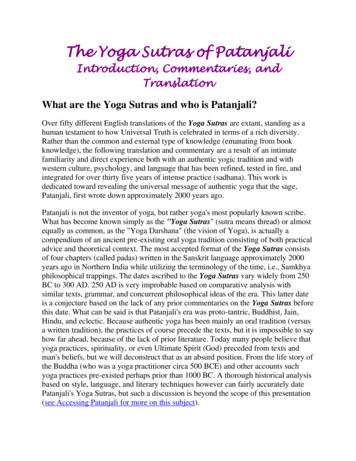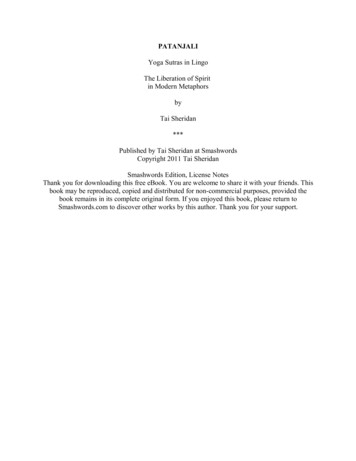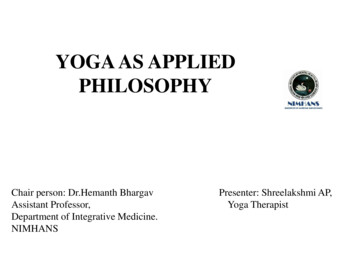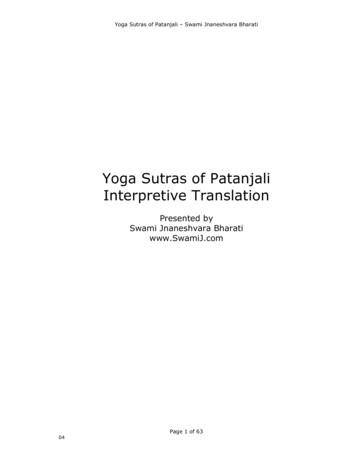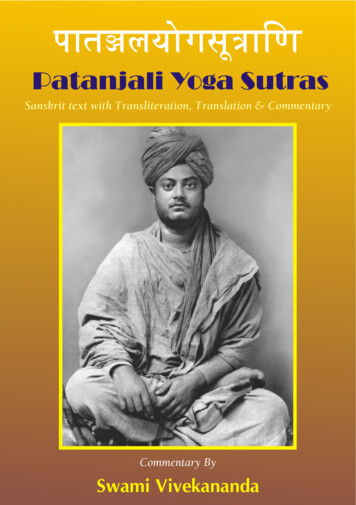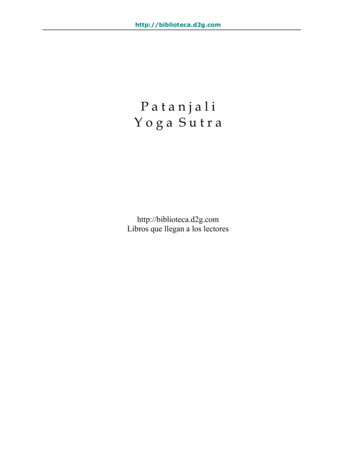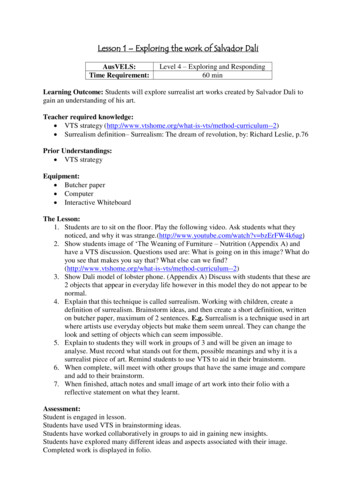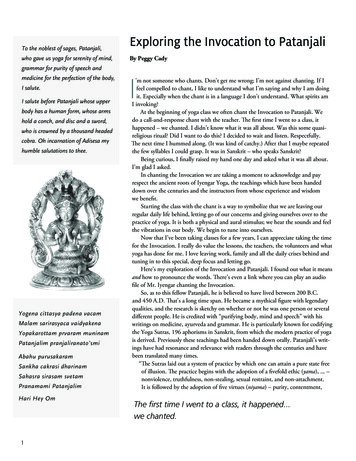
Transcription
To the noblest of sages, Patanjali,Exploring the Invocation to Patanjaliwho gave us yoga for serenity of mind,By Peggy Cadygrammar for purity of speech andmedicine for the perfection of the body,I salute.I salute before Patanjali whose upperbody has a human form, whose armshold a conch, and disc and a sword,who is crowned by a thousand headedcobra. Oh incarnation of Adisesa myhumble salutations to thee.Yogena cittasya padena vacamMalam sarirasyaca vaidyakenaYopakarottam prvaram muninamPatanjalim pranjaliranato’smiAbahu purusakaramSankha cakrasi dharinamSahasra sirasam svetamPranamami PatanjalimHari Hey Om1I’m not someone who chants. Don’t get me wrong; I’m not against chanting. If Ifeel compelled to chant, I like to understand what I’m saying and why I am doingit. Especially when the chant is in a language I don’t understand. What spirits amI invoking?At the beginning of yoga class we often chant the Invocation to Patanjali. Wedo a call-and-response chant with the teacher. The first time I went to a class, ithappened – we chanted. I didn’t know what it was all about. Was this some quasireligious ritual? Did I want to do this? I decided to wait and listen. Respectfully.The next time I hummed along. (It was kind of catchy.) After that I maybe repeatedthe few syllables I could grasp. It was in Sanskrit – who speaks Sanskrit?Being curious, I finally raised my hand one day and asked what it was all about.I’m glad I asked.In chanting the Invocation we are taking a moment to acknowledge and payrespect the ancient roots of Iyengar Yoga, the teachings which have been handeddown over the centuries and the instructors from whose experience and wisdomwe benefit.Starting the class with the chant is a way to symbolize that we are leaving ourregular daily life behind, letting go of our concerns and giving ourselves over to thepractice of yoga. It is both a physical and aural stimulus; we hear the sounds and feelthe vibrations in our body. We begin to tune into ourselves.Now that I’ve been taking classes for a few years, I can appreciate taking the timefor the Invocation. I really do value the lessons, the teachers, the volunteers and whatyoga has done for me. I love leaving work, family and all the daily crises behind andtuning in to this special, deep focus and letting go.Here’s my exploration of the Invocation and Patanjali. I found out what it meansand how to pronounce the words. There’s even a link where you can play an audiofile of Mr. Iyengar chanting the Invocation.So, as to this fellow Patanjali, he is believed to have lived between 200 B.C.and 450 A.D. That’s a long time span. He became a mythical figure with legendaryqualities, and the research is sketchy on whether or not he was one person or severaldifferent people. He is credited with “purifying body, mind and speech” with hiswritings on medicine, ayurveda and grammar. He is particularly known for codifyingthe Yoga Sutras, 196 aphorisms in Sanskrit, from which the modern practice of yogais derived. Previously these teachings had been handed down orally. Patanjali’s writings have had resonance and relevance with readers through the centuries and havebeen translated many times.“ The Sutras laid out a system of practice by which one can attain a pure state freeof illusion. The practice begins with the adoption of a fivefold ethic (yama), . –nonviolence, truthfulness, non-stealing, sexual restraint, and non-attachment.It is followed by the adoption of five virtues (niyama) – purity, contentment,The first time I went to a class, it happened.we chanted.
austerity, study, and dedication. These practices inhibit thenegative influences of being in the world. After adopting alifestyle centered on yama and niyama, one begins the stepby-step adoption of the asanas (postures), breath control,control over the sense, concentration, and meditation, eachof which should lead to the goal of samadhi (variouslydescribed as absorption or liberation).” 1B.K.S. Iyengar translated and commented on the philosophy of the Yoga Sutras of Patanjali in his book Light On theYoga Sutras of Patanjali. The Iyengar tradition and yoga practice are grounded in these teachings. Through this practice wecan transform ourselves to gain physical health, vitality, mentalclarity, wisdom, emotional serenity and poise, “and attain thegoal of yoga: kaivalya, liberation from the bondage of worldlydesires and actions, and union with the Divine.” 2What follows are two articles by Geeta Iyengar, about theInvocation to Patanjali. The first is a translation and commentson the Invocation itself. The second article is from a teachertraining paper, which discusses the symbolism of the Patanjalistatue. (You’ll want to stay on the good side of him.)1 Majumdar, Sachindra Kumar. Introduction to Yoga Principles and Practice.Secaucus, N.J.: Citadel Press, 1976.Patanjali. The Yoga Sutras of Patanjali: A New Translation and Commentary. Editedby Georg Feuerstein. Folkstoone, UK: Dawson, 1979. www.answers.com/topic/pata-jali#ixzz1IJ5vmvVM2 B.K.S. Iyengar. Light on the Yoga Sutras of Patanjali. Thorsons/Harper Collins,cover notes. London, UK: 1996.Geeta Iyengar’s Commentsand TranslationThe two slokas (verses) that we chantto invoke Lord Patanjali begin theBhojavritti, Bhoj’s commentary on theYoga Sutras. It says, first of all, thatLord Patanjali is considered to be theincarnation of Adhishesha, the cobra,which is the seat for the Lord Vishnu,the very creator of this world. It is saidhe took birth three different times, giving three differentsciences for people to improve themselves. The first is yoga.yogena cittasya padena vacamTo purify the mind (citta), purify the consciousness, Patanjaligave the science of yoga (yogena) to us. To purify our use ofwords (pada) and speech (vacca), he gave a commentary ongrammar to us, so that our use of words and way of speakingis clarified, distinct and pure.malam sarirasya ca vaidyakenaTo remove the impurities (malam) of the body (sarira), he gaveus the science of medicine (vaidyakena).yopakarottam pravaram muninamLet me go near the one who has given these things to us.patanjalim pranjalir anato’smiLet me bow down my head with my folded hands to LordPatanjaliInvocation to PatanjaliPhonetic pronunciationThen after knowing the work of this Lord, the second stanzasays what Lord Patanjali looks like. To do any meditationfirst the form has to be in front of the eyes.Yo-gay-nuh chih-tah-syuh pah-day-nuh vah-chahmabahu purusakaramFrom the hand up to the head he has the shape (karam) ofa human (purusa).Mah-lahm shah-ree-rah-syuh chuh vy-dyuh-kay-nuhYo-pa kar-oh-tahm prah-vah-rahm moo-nee-nahmPah-tahn-jah-lim prahn-jah-leer ah-nah-toe-smeeA-bah-hoo poo-roo-shah-kar-ahmShahn-kah chah-krah-see dar-ee-nahmSah-hah-srah sheer-ah-sahm shvay-tahmPrah-nuh-mah-mee pah-tahn-ja-limHar-ri hey OmNote: there is a recording of B.K.S. Iyengar recitingThe invocation at www.iyssb.com/misc.html(scroll down the page).sankha carkrasi dharinamIn his hand he is holding the conch (sankha) and disc (cakra)sahasra sirasam svetamOn top of his head (sirasam) he has got a thousand (sahasra)hoods of the cobra, because he is the incarnation of Adishesha,the greatest cobra. Svetam means white.pranamami patanjalimI bow down to PatanjaliWe chant so that at the very beginning that feeling of sanctification comes from inside, with the feeling of surrenderingoneself, because nothing can be learned in this world unlessyou have the humility to learn. So the moment you think of2
And you can’t learn anything unless you comedown; if you think you are on the top and youknow everything, then you are not a learner at all.In that sense, the chanting helps.IMAGE: Wikimedia Commonsthe Lord [Patanjali] at the beginning of doing a practice, you know thatyou are very small in front of that greatest soul. Once that is understoodthen the other problems which always arise while practicing, mainlyconcerned with the ego, will be affected. You know that you are “comingdown” to learn something. And you can’t learn anything unless you comedown; if you think you are on the top and you know everything, thenyou are not a learner at all. In that sense, the chanting helps.3Aumname of GodYogaunion of man with GodcittamindPadawordWe decided to chant these two slokas from the very beginning. WhenGuruji asked us to practice yoga we started with this recitation. But wedidn’t do it in the classes because when people came as beginners, theyhad the idea that it is a religious prayer of concern only to Hindus. Ittook people a little while to understand. Whenever we had some publicprogram, a celebration such as Divali or Guruji’s birthday, we wouldrecite these prayers. People started taking interest and asking us what theprayers mean. When it was understood, everybody accepted it. For severalyears now we have been chanting these prayers before classes.Vachaspeechadapted from an interview given by Geeta at RIMYI in 1992 during the CanadaMalaimpuritiesintensive, conducted by Margo Kitchen, videotaped by Heather Malek,transcribed and edited by Judith M. in consultation with Marline Miller.SharirabodyVaidyakthe science of medicineYahone whoApakarotremovedTamhimPravaramthe greatestMunithe seerTeacher Training:The Patanjali InvocationPranjalifolding the palmsBy Geeta S. IyengarAnatabowing downAsmiamAbahuarms up to the thighsPurushakaramhuman shapeShankhaconchChakradisc, a circular amheadSvetamwhitePranamamiI am bowing down andpaying respectPatanjalimto PatanjaliHariLord VishnuAdapted by Francis Ricks.The full transcript of this talk is published in Yogadhara. This text is fromwww.iyengaryogaamsterdam.com, Teachers Training Program Document2009.pdfNow let me tell you about the Patanjali invocation and the meaning ofthe invocation and their symbol ism. The invocation begins with Āum.Āum is the first primordial sound, an adi nada, a melodious, sonorousand sublime sound. The three syllables Ā, U, M represent the entire rangeof sound and creation. They represent the waking dream and sleep statesof consciousness. The crescent symbolizes the transcendental state. Āumis pranava which means exalt ed, unsurpassable praise of the supremeprinciple, the divinity. According to Patanjali it symbolises Isvara, thedivinity “tasya vacakah pranavah.” Being the source of all energies Āumis uttered as an auspi cious beginning. No sacred activity will be complete,profound and per fect without effecting the supreme grace and Āum is thegreatest invo cation to seek that grace.
The invocation we chant first is as follows:To the noblest of sages, Patanjali, who gave us yoga for serenity ofmind, grammar for purity of speech and medicine for the perfection of the body, I salute.The second part describes the statue of Patanjali:I salute before Patanjali whose upper body has a human form,whose arms hold a conch, and disc and a sword, who is crownedby a thousand headed cobra. Oh incarnation of Adisesa myhumble salutations to thee.The authors of [these] invocation are actually unknown.It was never the custom in those days to mention the nameof oneself as an author or a writer. However, some traditionalbooks mention that abahu purusakaram was written by KingBhojadeva in 1,100 AD, author of Rajamartanda Vrtti, acommentary on the Yoga Sutras.Each aspect of the statue of Patanjali carries meaning likethe intricately worded sutras.When one gazes at the idol of Sage Patanjali one sees thethree and a half coils below the navel. The three coils indicatethe Pranava Aum, a mystical symbol conveying the conceptof God as generator, organizer and destroyer. It signifies him asomnipresent, omnipotent and omniscient. Aum is composed ofthree syllables, A, U and M with a crescent and a dot onthe top.The three completed coils symbolize the syllables and thehalf coil, the crescent. It also represents the three gunas of prakrti,namely sattva, rajas and tamas and an aspirant aiming at thetrigunatita state, which is a transcendent state. Sage Patanjaliinvites our attention towards the three types of afflictions,namely adhyatmika, adhibhautika and adhidaivika, which are tobe conquered by following the path of yoga. The three coils indicate that he is a master of Yoga, Grammar and Ayurveda.The half coil indicates the reaching of the state of kaivalya.The conch, in the left hand, signifies the state of alertness,attentiveness and readiness to face obstacles, which are inevitable in the practice of Yoga. In olden days the conch was blownas a warning call to get ready to face disaster or calamities as itis done nowadays with sirens. It is also a symbol of jnana.The disc, in the right hand, signifies the destruction ofignorance with supreme effort and is a symbol of protection.The sword, tucked in the waist, indicates the cutting of theego, pride or sense of “I” which is the main obstacle coveringpure being. It is a sword of jnana to vanquish jnana. Thesethree weapons also indicate the restraint of mental fluctuations,removal of obstacles and the eradication of afflictions throughthe practice of Yoga.The hood above the head is an assurance of protection fromAdisesa, King of serpents. This protection always remains forthe practitioner, provided he surrenders to the Lord, which issignified in the atmanjali mudra, hands folded in namaskara.4The Bhagavatam narrates the story of the birth of Lord Krsna.Since Vasudeva was alerted by the Gods in heaven, that hiseighth child Krsna will be killed by Kamsa, he takes the infantKrsna from Mathura to Gokul to protect him for the demonKamsa. The river Yamuna was flooded as it was raining catsand dogs. At that juncture Adisesa protected Vasudeva and theinfant Krsna by holding the hood over them like an umbrellaand made a way, right in the middle of the river, so thatVasudeva could cross the river easily. Lord Patanjali indicateswith his hood, that he is our protector, provided we destroythe evils hidden within us by the sword of Yoga, purifyingourselves with yogic Sadhana.The thousand headed cobra, sahas ra sirasam svetam, indicates that Patanjali guides us in a thousand ways by showingus the several methods of practice and the approach to find theSoul within.The idol of Patanjali shows him as half-man and halfserpent. The human form indicates the individuality of man,since he has been endowed with intelligence to use his ownefforts to reach the goal. The form of the serpent suggests themotion and continuity of Sadhana, which cannot end until thegoal is reached.Patanjali guides us to move like a serpent, intensely, silentlyand fast on the path of Yoga and to be a tivrasamvegin, theultimate type as a pupil. If you have understood the significance, offer your prayers with a mind of prayerfulness so thatyou know what Sage Patanjali means by tajjapah tadarthabhavanam, that means – recite the prayers knowingly, repeatedly,devotedly.Let me now give you some of the qualities of Patanjali,according to his works. Patanjali is an immortal, versatilepersonality, a master of diverse knowledge with divine quali ties. He is a dharmin, virtuous and pious in deeds, a tapasvin, abhaktin, a sannyasin and a devout practitioner. He is an artist, askilled dancer, a scien tist, a mathematician, an astronomer, ascholar, a physicist, a psychologist, a biologist, a neurolo gist, asurgeon, a skilled physician and an educationist par excellence.He is an incarnation of glorious qual ities, in sraddha, virya andvairagya. He is an expert in psychological and chronologicaltime, as well as in the science of gravity. He transcends the purusarthas namely, dharma, artha, kama and moksa, as well as prkriti.He has unsurpassable memory and is well versed with natureand its functions. Yet he remains a pure being, a perfect siddhan,a realized Soul. All these qualities suffuse the life of Patanjali.This is not an exaggeration. The siddhis mentioned in theVibhuti Pada, relate to various aspects of existence, cosmos,body, mind and bear the stamp of his authentic and profoundexperience. Let me conclude this immortal journey, dearsadhakas, with an anjali, a sublime offering. The faith inourselves should grow with understanding. When the ego
begins to dissolve, the eyes begin to see the greatness of theinspired teachings of one of the most original thinkers whoever lived. We are mortals and Patanjali is an immortal Soul.Just as a river does not retain its identity while merging intothe sea, let us through our practices merge into the river ofburning light of Yoga, passed onto us by Sri Patanjali.Patanjali guides us to move like a serpent,intensely, silently and fast on the pathof Yoga and to be a tivrasamvegin, theultimate type as a pupil.Hari om tat sat.Why Do We Chant Om?by Krisna ZawadukOm is a sacred syllable. It is called pranava. Om represents divinity; it is the sound of creation, the soundthat was made when the Universe was created. GeorgFeuerstein writes that “It [Om] is generally regarded asthe primordial sound that reverberates throughoutspace and time at the most subtle level of cosmic existence.” Sound is vibration, and is at the source of allcreation. “God is beyond vibration,” B.K.S. Iyengarsays, “but vibration, being the subtlest form of Hiscreation, is the nearest we can get to him in the physicalworld.”Om’s history is long indeed. Initially, it was a secretive and sacred practice that was only passed fromteacher to disciple by word of mouth. Since then, itsimportance has been mentioned in many scripturessuch as the Upanishads, The Bhagavad Gita and the YogaSutras of Patanjali.Om is meant to be chanted with its meaning inmind. The sound OM is meant to resonate within,to take us inwardly. The chanting of this most simplemantra has an effect on our nervous system and focusesour inner environment. Om is actually made up ofthree distinct parts/sounds: “A”, “U” and “M”. Thus,it is often spelled AUM. These parts refer to the past,present and future, the states of waking, dreaming anddeep sleep. It refers to speech, mind and the breath oflife plus the mother, father and preceptor.We chant Om at the beginning of class so that wecan connect to the Universe, to God and to our higherSelf. It develops humility. We use Om to sanctify andpurify our practice. We produce the sound of our ownOm, which merges with the Oms of others. This issymbolic of our interconnection with each other ashuman beings.Om chanting links:www.youtube.com/watch?v ZdukkTAJE0U&feature relatedwww.youtube.com/watch?v CRj9SFQqwXY&feature relatedFor an interesting listen to the sound of the Big Bang, click thislink. (Audio simulation of the sound waves present in the first760,000 years of the birth of the Sound.htmlKrisna Zawaduk is a teacher in Kelowna. This article isreprinted from the Kelowna Yoga House ticle.5
Yoga Sutras of Patanjali. The Iyengar tradition and yoga prac-tice are grounded in these teachings. Through this practice we can transform ourselves to gain physical health, vitality, mental clarity, wisdom, emotional serenity and poise, “and attain the goal of yoga
